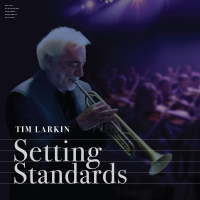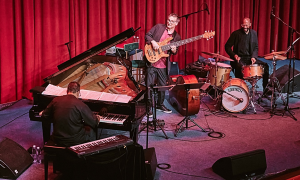Home » Jazz Articles » Profile » Matthew Shipp: Shipp Shifts
Matthew Shipp: Shipp Shifts

The Trio
The trio is Shipp's main vehicle. It is, by turns, his midnight train, his slow boat to China and a way of flying home. It takes a hike, rides a bike and covers lots of ground. It sails and it soars. And who can better describe it than the ensemble proprietor himself?
"One thing I learned from my 16 years in the David S. Ware Quartet is the importance of a unit really being a unit," says Shipp. "I knew that before David, but he reinforced that idea. In these days, often because of economic need, so many musicians function as journey people. And there is nothing wrong with that—and often great music is produced—but there is something about a band that has made a commitment to develop a music together, where the band becomes a lifestyle.
"In my music, I really depend on a deep relationship with my bassist. That relationship both grounds me and frees me up. People who have followed my music in the past know the names associated with me in this realm. Enter Michael Bisio, the bassist in my current trio. For lack of a better word he is a monster. Monster sound, chops, knowledge, faith in where the music can go, instinct to follow my phrasing etcetera, etcetera, etcetera. I depend on a bassist—I wrap my lines around their lines—and if I was a pitcher in baseball I would probably be someone unorthodox like Satchel Paige.
"I like to throw the rhythm section sliders, changeups, spit balls along with my fastball. Bisio always knows exactly what part of the plate the ball is going over no matter what pitch I throw. I really depend on my bassist—maybe Shipp is a vampire who sucks the blood from the bassist.
"Even though my relationship with my bassist is clear cut, my relationship with the drummer is always more problematic, paradoxically that was the same situation with David S. Ware who went through four drummers over the period I was in the quartet. Whit Dickey is my drummer of choice in the trio. Whit is an idiosyncratic artist who brings a very unique and special set of variables to the equation. First it's his sound—he gets a very beautiful sound out of the drums—we have borrowed other drummers drums at gigs and after the gig the drummer we borrowed it from have marveled at how Whit tunes their drums.
"Whit is idiomatic for the jazz avant-garde—whatever that is—but he does not play any jazz avant-garde clichés, and does not sound like any of the forefathers of drumming in this area. I also need a balance of someone who can mark off pulse when needed and someone who can be a colorist and not get in the way of my phrasing—I don't know if there is a "perfect balance" of this—and if it is one I don't know if we get it all the time. All I know is when the gig is going well it feels really good with this particular configuration. Whit is very interesting in the fact that he is a very analytical person but there is also an aspect of him that is an idiot-savant. Very interesting cat.
"Anyway this is my trio," Shipp concludes. "I think we are doing something very unique in this period of the music—the trio music for us is a lifestyle, and actually our life is a certain way. For us the trio is a vehicle for transcendence and hopefully our language is a vehicle for transcendence for our audience."
Michael Bisio rises very well to the occasion of being a sonic navigator and more or less puts the full measure of effort as a performing musician into his trio participation. This applies equally well to Whit Dickey.
Bisio found his way here from the Puget basin, where he formed a lasting friendship with bassist Dan O'Brien and was an avid participant in the area's unusually vivacious jazz milieu. The two work with piano as if bass and drum kit were complementary outriggers of pianistic essence.
Says Bisio, "John Sharpe's AAJ review of our 2011 Vortex [London] performance opens with this quote from a patron: 'I'm not that keen on piano trios but you can't fault this one.' His penultimate sentence states 'Nonetheless, the rapturous applause from the standing room only crowd made one thing clear: piano trios don't come any better than this.'
"Let me start by saying I believe the Matthew Shipp Trio is the finest piano trio in creative music today. Our individual histories include intense studies and great love for the traditions that are the hallmarks of the musics we have made our own, not merely in an academic sense but in the spirit of the music and the artists who have come before us. As individuals we continue to hone our craft and practice our art on a daily basis. These strengths give us the vision and ability to move our music forward.
"One of my basic ideas about free music is there is none; there is freedom of choice and the ability to be in the moment, Matthew is a monster at both, his ability to lead should be seen as the iconic model. A bandleader with such complete mastery who absolutely embraces the contributions of others is a rare human. Because of these qualities the music becomes all we are and more. Even the audience becomes an integral part of the process. One of the greatest compliments I hear at concerts goes something like this : 'I didn't think I even liked this music until I heard you guys!'

"A very wise friend of mine often says: 'Don't postpone the joy !' The Matthew Shipp Trio never does."
Whit Dickey practices a kind of stewardship in his relationship to music and the community it belongs to. His full range of capabilities can be heard on Transonic (AUM Fidelity, 1998), a trio with saxophonist Rob Brown and bassist Chris Lightcap.
His participation in the trio is more subtle as he is very keenly attuned to the agreed aesthetics of the trio sound. There is a sumptuous use of well-flowed tom timbres to extract tones faithful to the counterpart meeting of the piano hammer on its string. It makes for a nice weaving around whether the piano is a bunch of tiny tuned drums or a drum is a simple piano.
"The most important thing about Matt's music is the sound he projects out of his instrument," says Dickey. "What do I mean by sound? It's the organic unity of melody harmony and rhythm that is generated from the minute Matt touches the piano. This is what one hears in all great pianists, and it is particularly evident during solo moments. Matt's music has tremendous power even in the most delicate minimal phrasing. There are all sorts of inner melodies and harmonies at work in his phrasing. A multidimensional approach capable of both swing, multidirectional linearity and his trademark style, whose shapes and structures delve beyond linear rhythm.
"As I said it's a music—like the leader he worked with for 16 years, David S. Ware—with tremendous power. and it relies on a drummer sensitive to the profound vibration it generates. I've learned over the years to instantly translate mantra-like vibration I hear into time and pulse integral to the music. Bassist Mike Bisio, who adds so much to Matt's sound, makes this all the easier.
"So out of this we have a our own unique and special kind of unity, wherein we feed off each other and the music takes on all different kinds of shapes, colors and directions like no other piano trio. It's a true joy!"
Remembrance By Discography A Matthew Shipp Guide to David S. Ware Recordings
2012 was David S. Ware's last year here. His first was 1949. You'd think he'd get a bit more, but no. Shipp provides his own summation of highlights from his work with Ware over the years with the following selection of recordings:
Flight of I (DIW, 1991) "David's first CD on DIW, it sets the template for all of his future work with quartet. 'Aquarian Sound' represents David and his tone at its melodic apotheosis. The deconstruction of standards started in earnest with a version of 'Yesterdays' and 'There Will Never Be Another You.' And the cut 'Infi-Rhythms' represents David at his most profound as a composer who can get the most out of little kernels of material. Marc Edwards is the drummer on this CD."
Third Ear Recitation (DIW, 1992) "Two versions of 'Autumn Leaves'—the first is Ware at his most aggressive. [Saxophonist]James Carter once said in a blindfold test in Downbeat when this cut was played, something to the effect, (this is a paraphrase): 'In autumn the leaves come off the tree but this brother is trying to knock the tree down.' The second version is a ballad and I must say there is a piano solo that I think is special. This is the first CD that I think I figured out a certain rhythmic effect you can get on Yamaha pianos and I exploit that to the nth degree on [saxophonist] Sonny Rollins' tune, 'East Broadway Rundown' and David's tune 'The Chase.' Also we do 'Angel Eyes,' which we kept in the book for years and I did it with my trio also. 'Mystic March' is one of David's greatest tunes. Whit Dickey is on drums on this CD."
Cryptology (Homestead, 1995) "David's first CD on Homestead records, which was an indie rock label, and this CD has all the energy and the vibe of that whole period. The energy is even more stunning when I remember how sick David was when we recorded it.
"He had a tremendous flu and I tried to talk him into going in a week later but he felt the band was pumped and ready so we went in. This is a time piece of that period when punk rock labels where recording free jazz.
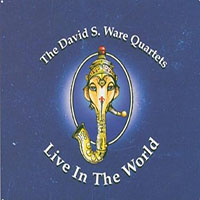 "It was also the lead review in Rolling Stone magazine. It was a three-CD review with Ware and my trio CD, Circular Temple, (Infinite Zero, 1995), which had been reissued by punk rock icon Henry Rollins and Def Jam record producer Rick Rubin on American Recordings. The third CD in the lead review was a reissue of Live in Japan (Impulse!, 1991), by [saxophonist] John Coltrane. We were the first jazz CDs ever to be lead review in Rolling Stone history, which got the editor in trouble with Jann Wenner, the owner, but I think the editor wanted to make history."
"It was also the lead review in Rolling Stone magazine. It was a three-CD review with Ware and my trio CD, Circular Temple, (Infinite Zero, 1995), which had been reissued by punk rock icon Henry Rollins and Def Jam record producer Rick Rubin on American Recordings. The third CD in the lead review was a reissue of Live in Japan (Impulse!, 1991), by [saxophonist] John Coltrane. We were the first jazz CDs ever to be lead review in Rolling Stone history, which got the editor in trouble with Jann Wenner, the owner, but I think the editor wanted to make history."Godspelized (DIW, 1996) "This might be David's greatest CD. I think so. He thought so. He said to me on a few occasions that we were possessed and taped into some realm that no one ever has on this particular CD. There is something utterly transcendental about this CD. Susie Ibarra is on drums."
Live In The World (Thirsty Ear, 2005) "David on Thirsty Ear Blue Series—a three-CD set with three different live gigs, a gig in Switzerland with Susie Ibarra on drums, a gig in Terni, Italy with Hamid Drake on drums (who was subbing for Guillermo), and a gig in Milano, Italy with Guillermo E. Brown on drums."
Freedom Suite (AUM Fidelity, 2002) "This is on AUM Fidelity and is Sonny Rollins' piece, the 'Freedom Suite.' Sonny gave us his blessings and, of course, there was no piano on the original version of Sonny's. Our version has the Ware sound but the material of the composition does shape things and intersects with our sound world. It might be one of the most fascinating CDs of that period."
Collaborations: Barb J. and Steve D.
"Collaborating with artist outside of music is a long tradition that vivifies your own art plus helps create hybrid headspaces—and it's fun—and lessons learned about time/space of other art forms can feed back into the music and make you look at time/pace and syntax in a different light," says Shipp.
"I have had a long term collaboration with poet Steve Dalachinsky. He understands the metaphysics of my music completely and has a knack for writing words that convey what some of his favorite jazz artists might be saying if they dealt with discursive language. In other words, he feels the rhythm and the resonance of the language.
"Collaborating with visual artist Barb Januskiewicz is something from the last year. She has an amazing project with saxophonist Dave Liebman, where she does live action painting to the music as a member of the "band.'
"My work with her is a collaboration on a film project, The Composer. Again, resonance is what draws me in and she has an innate feel for the resonance of the breaking of the circle and the linear forms that generate out of that.
"And with that, she generates fresh images that capture the resonance and color of modern jazz gestures."
"I take my influences and preferences in both music and art and try to fuse them in an aesthetic expression," says Januskiewicz. "There are works of art that one can react to instantly. These work all at once and are aesthetic experiences that unify and impose boundaries on the license of eye and ear.
"Other works of art achieve a dissociated and dissociating effect. They are the works that cannot be experienced or understood as feats of synthesis, or as products of a single point of view.
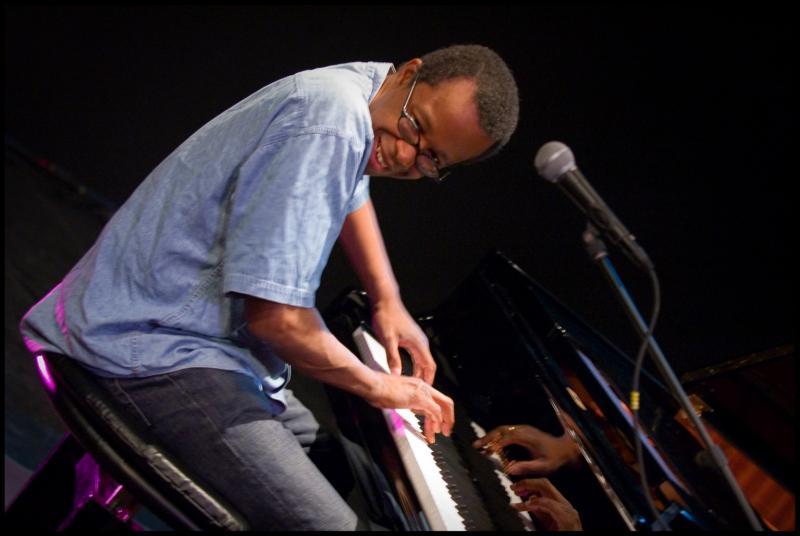
"My works are layers, with multiple perspectives. Much of my art can be described as an effort toward a radical disaffiliation of elements using patterns and textures. I like going deeper and reaching for awareness of a quarrelsome relationship between two presumably incompatible ways of experiencing works of art .
"I see the 'total' or unified work on the one hand and the dissociated asynchronous work on the other. I bring in music as my main influence, in my new visual work and it has helped me achieve this vision. I see musical shapes, not really objects, I visualize them, arranged coextensively in space. I try to reach that single, unimpeachable moment—then capture with a frozen moment on my canvas.
"Moving from painting into cinema is like an evocative poems gathered power, how the words can move you, to visualize. I never think of an audience or an art collector when creating works. Art that involves interactive happenings clutters my mind with multiple points of view. Many new sound and image installations require a spectator who continuously pays, rather than receives or reframes, attention. By contrast I am doing a total immersion on a two-dimensional surface, a sensorial experiences with my 2D art, expressing vibrations, seeing perhaps sound and reacting to the music.
"Under these conditions, two supplementary models work for me: the scientist and the mystic dreamer. I'm inclined to be fascinated with technology and the possibility of using these new tools, exploring the possibilities and bringing them into my environments on my canvas with traditional paper and paint brushes. One is the domain of hypothesis and repetition, of the chance operation; what happens if? Then the other, of strenuousness and self-abnegation, of a sensibility that deploys extreme states of feeling and reacting.
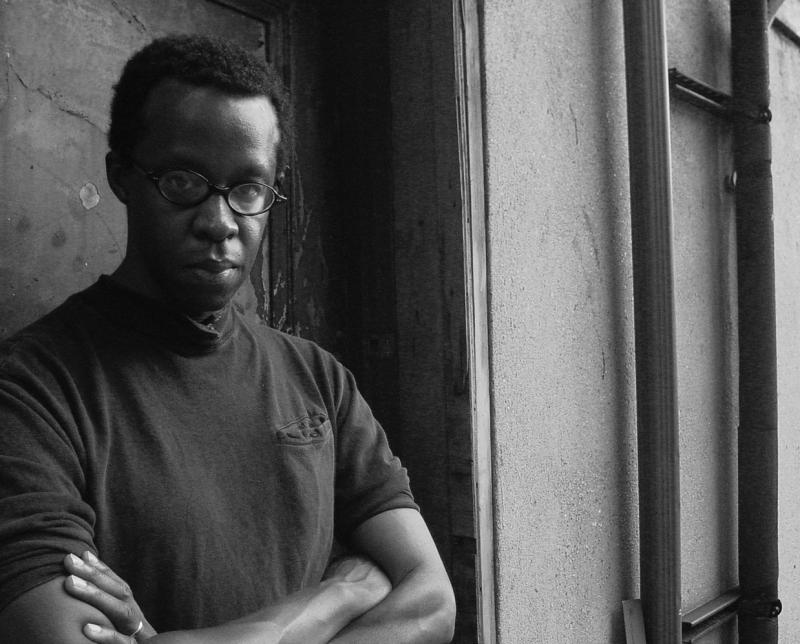
"I guess, in the long run, you can say I am a painter who takes her visual expressions from sound and, in this case, from Matthew Shipp's music."
Steve Dalachinsky is one of a few Americans who is eagerly paid by French people to speak English. He graciously contributed a few written observations about his collaboration with Matthew Shipp beginning with a sense of his aesthetic aims.
"This is a(n) (inter)changeable act crystal can crack heighten suspend emit/ heal/torture and illumine," says Dalachinsky. "All my processes, as I discovered recently, seem to lead to and add up to one process (the act of) doing.
"Recently I wrote/typed up five poems. As I prepared to do this I was listening to a samba program on the radio strictly by chance. I had wished they played some Martinho da Vila, which they eventually did. As I listened I began spontaneously typing a piece that eventually came to an end. Then I started working on fragments I had recently written that were lying around.
"Though they were five seemingly different pieces with different elements, by the time I got to the fifth one, (all combining what had been scribbled along with some instant editing), I discovered, in this case anyway, they had become consciously or unconsciously interconnected and by the end had, as a result, come full circle so to speak.
"It's like what Matthew does live with his long sets weaving in and out of standards, originals and improvisation to make one long organically, (or so it would appear), intertwined set
"Once, when I was very young, I saw Thelonious Monk interviewed on a TV show. The interviewer asked him, as Monk sat at the piano (I don't recall if he had finished playing or was about to play), something to the effect of.. 'Thelonious, folks say you play differently than other people. What is it exactly that you do (differently)?' 'I don't know, I just do it.' was how I remember Monk replying. Head down. Then I think he played. Well for years I thought I got it. He just does it. Then I thought, at some point as I grew older—but not wiser or up (as in mature)—'Well, he must know but he'd either rather not explain or can't really articulate it.' Anyway, I realized that after I had written these five pieces that, although the processes seemed to differ, they equaled, as I said earlier, one process the act of doing.
"It's like the deep. Swimming in the deep. No matter how shallow the pool may appear. Then there are those shimmering expanding woven quirky reflections of light along the bottom. And I finally realize it's about slowing time down and speeding time up, like in a movie/film how fast the swimmer chooses to move his arms with what intensity & how the breath holds up. Even crazy people read & write some kind of script, language and tempo in order to keep going/moving/sustaining/breathing."
Dalachinsky here offers a sense of how their collaborations flow: "Smooth, long and continuous like his live sets, except the duo recording—which was shorter pieces and on which he experimented more—and the cuts were more delineated and in some cases very short.
"But in all cases there was little or no discussion, all improv on his part and some on mine, though all work was written. No rehearsals. One or two on-the-spot questions from him and we begin and we end as I do and he does in most gigs of this nature (I hate recording and prefer live, the mess-ups are easier to handle)."
Dalachinsky concludes with a summation of how his poetic language interacts with Shipp's sonic language: "I think this is different each time. Sometimes we listen to each other. Sometimes we hear each other. Sometimes we pay no attention to the other and just see what happens. We dialogue or go our separate ways. Sometimes it' smooth, sometimes awkward but for the most part though, uncomfortably satisfying. It usually works out."
Photo Credits
All Photos: Courtesy of Matthew Shipp
Tags
Matthew Shipp
Profiles
Chris Rich
United States
New York
New York City
David S. Ware
Michael Bisio
Whit Dickey
Dan O'Brien
Rob Brown
Chris Lightcap
Marc Edwards
James Carter
Sonny Rollins
John Coltrane
Susie Ibarra
Hamid Drake
Guillermo E. Brown
Steve Dalachinsky
Dave Liebman
Thelonious Monk
PREVIOUS / NEXT
Matthew Shipp Concerts
Support All About Jazz
 All About Jazz has been a pillar of jazz since 1995, championing it as an art form and, more importantly, supporting the musicians who make it. Our enduring commitment has made "AAJ" one of the most culturally important websites of its kind, read by hundreds of thousands of fans, musicians and industry figures every month.
All About Jazz has been a pillar of jazz since 1995, championing it as an art form and, more importantly, supporting the musicians who make it. Our enduring commitment has made "AAJ" one of the most culturally important websites of its kind, read by hundreds of thousands of fans, musicians and industry figures every month.












